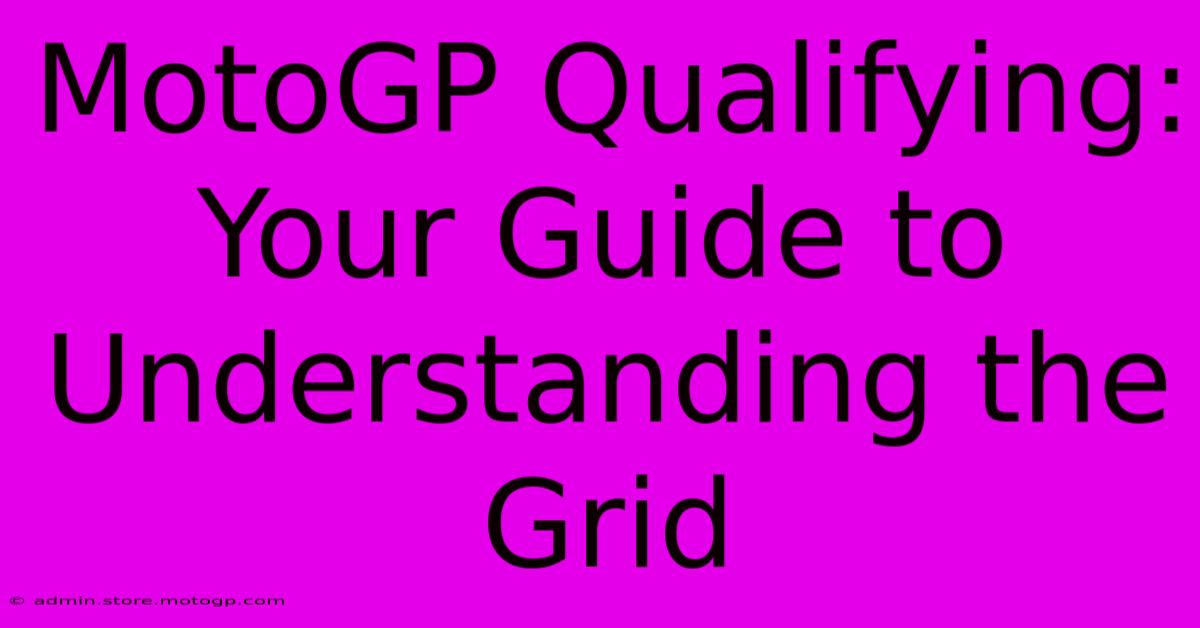MotoGP Qualifying: Your Guide To Understanding The Grid

Table of Contents
MotoGP Qualifying: Your Guide to Understanding the Grid
MotoGP, the pinnacle of motorcycle racing, boasts breathtaking speeds and nail-biting competition. But before the lights go out on race day, there's the crucial qualifying session that determines the starting grid. Understanding how MotoGP qualifying works is key to fully appreciating the race itself. This guide will break down the process, explaining the different sessions and how riders fight for the coveted pole position.
The Importance of Qualifying in MotoGP
The starting grid in MotoGP is incredibly important. A good starting position significantly increases a rider's chances of winning the race. Starting at the front allows riders to control the pace, avoid traffic jams, and make crucial overtakes early on. Conversely, a poor starting position can make the race considerably harder, requiring more aggressive maneuvers and potentially leading to collisions. Therefore, MotoGP qualifying is a high-pressure event where even fractions of a second can make a huge difference.
The Qualifying Format: A Step-by-Step Breakdown
The MotoGP qualifying process is designed to create a fair and exciting battle for grid positions. It unfolds over several sessions, each with its own set of rules and consequences.
1. Free Practice (FP1, FP2, FP3):
These sessions are crucial for teams to test different bike setups, tires, and strategies. Data collected here informs the decisions made during qualifying. While FP results don't directly impact grid positions, the combined times from all three free practice sessions determine which riders progress directly to Q2. The top 10 riders from the combined FP times automatically advance to Q2.
2. Qualifying 1 (Q1):
The remaining riders, those who didn't finish within the top 10 in the combined free practice sessions, compete in Q1. This session is a fierce battle for the remaining two spots in Q2. Only the two fastest riders from Q1 will progress. The pressure is immense, as riders are fighting for their place amongst the top 12 on the grid.
3. Qualifying 2 (Q2):
Q2 is where the real excitement lies. The top 10 riders from the combined FP sessions, along with the two fastest from Q1, compete for pole position and the best starting grid positions. This session is a time trial, with riders pushing their machines to the absolute limit in a quest for the fastest lap time. The rider with the fastest lap time earns pole position, the coveted first spot on the grid.
Understanding the Grid: Pole Position and Beyond
The grid is arranged based on the final qualifying results. The rider who achieves the fastest lap time in Q2 claims pole position, starting the race from the front of the grid. The remaining riders are positioned behind, based on their qualifying times – second fastest in the second position, third fastest in third, and so on.
Pole Position: The ultimate goal of MotoGP qualifying. It offers a significant advantage in the race.
Front Row: The top three positions on the grid (pole, second, third).
Second Row: Positions four through six.
Third Row: Positions seven through nine.
Fourth Row: Positions ten through twelve and so on...
Strategies in Qualifying: A Look Behind the Scenes
Teams and riders employ various strategies during qualifying. These can include using different tire compounds, focusing on single flying laps versus consistently fast laps, and carefully managing fuel levels. Analyzing these strategic choices is a fascinating aspect of understanding the complexities of MotoGP racing.
Conclusion: Mastering the Grid
Understanding the intricacies of MotoGP qualifying is crucial for any serious fan. The process, from free practice to Q2, provides a gripping drama that culminates in the formation of the starting grid for the race. The fight for pole position and the strategic nuances employed by teams and riders all contribute to the compelling spectacle that makes MotoGP so enthralling. So next time you watch a MotoGP race, remember the fierce battle fought in qualifying, and appreciate how much the starting grid impacts the race outcome.

Thank you for visiting our website wich cover about MotoGP Qualifying: Your Guide To Understanding The Grid. We hope the information provided has been useful to you. Feel free to contact us if you have any questions or need further assistance. See you next time and dont miss to bookmark.
Featured Posts
-
Moto Gp Sprint Race A Celebration Of Speed
Feb 18, 2025
-
Lot F Cota Take Control Of Your Area Of Life
Feb 18, 2025
-
Witness Velocity Moto Gps Speed Kings
Feb 18, 2025
-
Austin F1 Qualifying A Drivers Perspective
Feb 18, 2025
-
High Definition Moto Gp Images For Your Desktop
Feb 18, 2025
